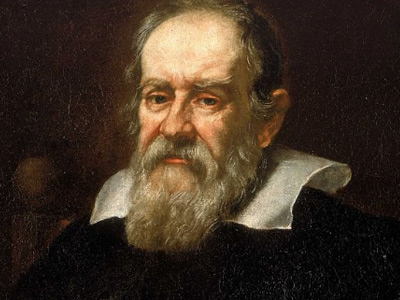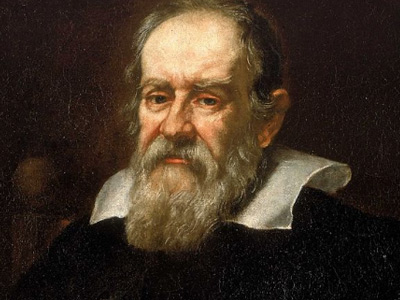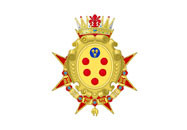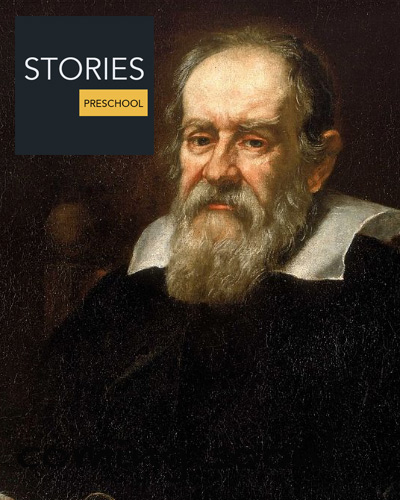Career as a Scientist
Although Galileo seriously considered the priesthood as a young man, at his father's urging he instead enrolled in 1580 at the University of Pisa for a medical degree. In 1581, when he was studying medicine, he noticed a swinging chandelier, which air currents shifted about to swing in larger and smaller arcs. To him, it seemed, by comparison with his heartbeat, that the chandelier took the same amount of time to swing back and forth, no matter how far it was swinging. When he returned home, he set up two pendulums of equal length and swung one with a large sweep and the other with a small sweep and found that they kept time together. It was not until the work of Christiaan Huygens, almost one hundred years later, that the tautochrone nature of a swinging pendulum was used to create an accurate timepiece. Up to this point, Galileo had deliberately been kept away from mathematics, since a physician earned a higher income than a mathematician. However, after accidentally attending a lecture on geometry, he talked his reluctant father into letting him study mathematics and natural philosophy instead of medicine. He created a thermoscope, a forerunner of the thermometer, and, in 1586, published a small book on the design of a hydrostatic balance he had invented (which first brought him to the attention of the scholarly world). Galileo also studied disegno, a term encompassing fine art, and, in 1588, obtained the position of instructor in the Accademia delle Arti del Disegno in Florence, teaching perspective and chiaroscuro. Being inspired by the artistic tradition of the city and the works of the Renaissance artists, Galileo acquired an aesthetic mentality. While a young teacher at the Accademia, he began a lifelong friendship with the Florentine painter Cigoli, who included Galileo's lunar observations in one of his paintings.
In 1589, he was appointed to the chair of mathematics in Pisa. In 1591, his father died, and he was entrusted with the care of his younger brother Michelagnolo. In 1592, he moved to the University of Padua where he taught geometry, mechanics, and astronomy until 1610. During this period, Galileo made significant discoveries in both pure fundamental science (for example, kinematics of motion and astronomy) as well as practical applied science (for example, strength of materials and pioneering the telescope). His multiple interests included the study of astrology, which at the time was a discipline tied to the studies of mathematics and astronomy.
Galileo, Kepler and theories of tides
Cardinal Bellarmine had written in 1615 that the Copernican system could not be defended without "a true physical demonstration that the sun does not circle the earth but the earth circles the sun". Galileo considered his theory of the tides to provide the required physical proof of the motion of the earth. This theory was so important to him that he originally intended to entitle his Dialogue on the Two Chief World Systems the Dialogue on the Ebb and Flow of the Sea. The reference to tides was removed from the title by order of the Inquisition.
For Galileo, the tides were caused by the sloshing back and forth of water in the seas as a point on the Earth's surface sped up and slowed down because of the Earth's rotation on its axis and revolution around the Sun. He circulated his first account of the tides in 1616, addressed to Cardinal Orsini. His theory gave the first insight into the importance of the shapes of ocean basins in the size and timing of tides; he correctly accounted, for instance, for the negligible tides halfway along the Adriatic Sea compared to those at the ends. As a general account of the cause of tides, however, his theory was a failure.
If this theory were correct, there would be only one high tide per day. Galileo and his contemporaries were aware of this inadequacy because there are two daily high tides at Venice instead of one, about twelve hours apart. Galileo dismissed this anomaly as the result of several secondary causes including the shape of the sea, its depth, and other factors. Against the assertion that Galileo was deceptive in making these arguments, Albert Einstein expressed the opinion that Galileo developed his "fascinating arguments" and accepted them uncritically out of a desire for physical proof of the motion of the Earth. Galileo dismissed the idea, held by his contemporary Johannes Kepler, that the moon caused the tides. Galileo also took no interest in Kepler's elliptical orbits of the planets.
Controversy over comets and The Assayer
In 1619, Galileo became embroiled in a controversy with Father Orazio Grassi, professor of mathematics at the Jesuit Collegio Romano. It began as a dispute over the nature of comets, but by the time Galileo had published The Assayer (Il Saggiatore) in 1623, his last salvo in the dispute, it had become a much wider controversy over the very nature of science itself. The title page of the book describes Galileo as philosopher and "Matematico Primario" of the Grand Duke of Tuscany.
Because The Assayer contains such a wealth of Galileo's ideas on how science should be practised, it has been referred to as his scientific manifesto. Early in 1619, Father Grassi had anonymously published a pamphlet, An Astronomical Disputation on the Three Comets of the Year 1618, which discussed the nature of a comet that had appeared late in November of the previous year. Grassi concluded that the comet was a fiery body which had moved along a segment of a great circle at a constant distance from the earth, and since it moved in the sky more slowly than the moon, it must be farther away than the moon.
Grassi's arguments and conclusions were criticised in a subsequent article, Discourse on Comets, published under the name of one of Galileo's disciples, a Florentine lawyer named Mario Guiducci, although it had been largely written by Galileo himself. Galileo and Guiducci offered no definitive theory of their own on the nature of comets although they did present some tentative conjectures that are now known to be mistaken. In its opening passage, Galileo and Guiducci's Discourse gratuitously insulted the Jesuit Christopher Scheiner, and various uncomplimentary remarks about the professors of the Collegio Romano were scattered throughout the work. The Jesuits were offended, and Grassi soon replied with a polemical tract of his own, The Astronomical and Philosophical Balance, under the pseudonym Lothario Sarsio Sigensano, purporting to be one of his own pupils.
The Assayer was Galileo's devastating reply to the Astronomical Balance. It has been widely recognized as a masterpiece of polemical literature, in which "Sarsi's" arguments are subjected to withering scorn. It was greeted with wide acclaim, and particularly pleased the new pope, Urban VIII, to whom it had been dedicated. In Rome, in the previous decade, Barberini, the future Urban VIII, had come down on the side of Galileo and the Lincean Academy.
Galileo's dispute with Grassi permanently alienated many of the Jesuits who had previously been sympathetic to his ideas, and Galileo and his friends were convinced that these Jesuits were responsible for bringing about his later condemnation. The evidence for this is at best equivocal, however.
Controversy over heliocentrism
In the Christian world prior to Galileo's conflict with the Church, the majority of educated people subscribed either to the Aristotelian geocentric view that the earth was the center of the universe and that all heavenly bodies revolved around the Earth, or the Tychonic system that blended geocentrism with heliocentrism. Nevertheless, following the death of Copernicus and before Galileo, heliocentrism was relatively uncontroversial; Copernicus's work was used by Pope Gregory XIII to reform the calendar in 1582.
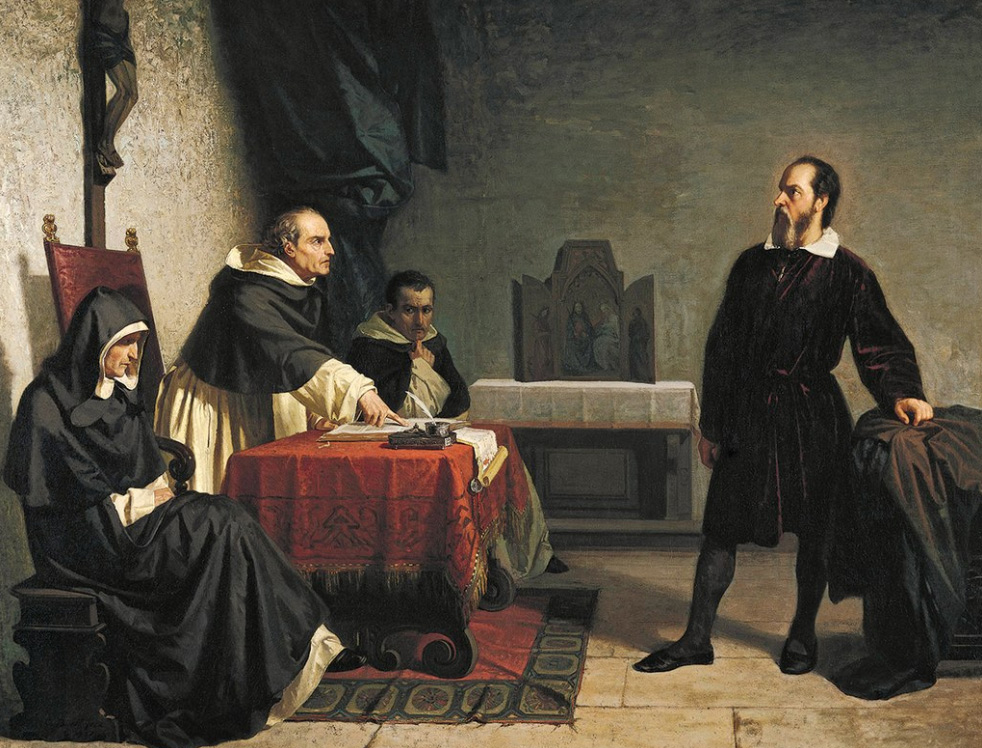
Cristiano Banti's 1857 painting Galileo facing the Roman Inquisition
Opposition to heliocentrism and Galileo's writings combined religious and scientific objections and were fueled by political events. Scientific opposition came from Tycho Brahe and others and arose from the fact that, if heliocentrism were true, an annual stellar parallax should be observed, though none was. Copernicus had correctly postulated that parallax was negligible because the stars were so distant. However, Brahe had countered that, since stars appeared to have measurable size, if the stars were that distant, they would be gigantic, and in fact far larger than the Sun or any other celestial body. In Brahe's system, by contrast, the stars were a little more distant than Saturn, and the Sun and stars were comparable in size.
Religious opposition to heliocentrism arose from Biblical references such as Psalm 93:1, 96:10, and 1 Chronicles 16:30 which include text stating that "the world is firmly established, it cannot be moved." In the same manner, Psalm 104:5 says, "the Lord set the earth on its foundations; it can never be moved." Further, Ecclesiastes 1:5 states that "And the sun rises and sets and returns to its place."
Galileo defended heliocentrism based on his astronomical observations of 1609 (Sidereus Nuncius 1610). In December 1613, the Grand Duchess Christina of Florence confronted one of Galileo's friends and followers, Benedetto Castelli, with biblical objections to the motion of the earth. According to Maurice Finocchiaro, this was done in a friendly and gracious manner, out of curiosity. Prompted by this incident, Galileo wrote a letter to Castelli in which he argued that heliocentrism was actually not contrary to biblical texts, and that the bible was an authority on faith and morals, not on science. This letter was not published, but circulated widely.
By 1615, Galileo's writings on heliocentrism had been submitted to the Roman Inquisition by Father Niccolo Lorini, who claimed that Galileo and his followers were attempting to reinterpret the Bible, which was seen as a violation of the Council of Trent and looked dangerously like Protestantism. Lorini specifically cited Galileo's letter to Castelli. Galileo went to Rome to defend himself and his Copernican and biblical ideas. At the start of 1616, Monsignor Francesco Ingoli initiated a debate with Galileo, sending him an essay disputing the Copernican system. Galileo later stated that he believed this essay to have been instrumental in the action against Copernicanism that followed. According to Maurice Finocchiaro, Ingoli had probably been commissioned by the Inquisition to write an expert opinion on the controversy, and the essay provided the "chief direct basis" for the Inquisition's actions. The essay focused on eighteen physical and mathematical arguments against heliocentrism. It borrowed primarily from the arguments of Tycho Brahe, and it notedly mentioned Brahe's argument that heliocentrism required the stars to be much larger than the Sun. Ingoli wrote that the great distance to the stars in the heliocentric theory "clearly proves ... the fixed stars to be of such size, as they may surpass or equal the size of the orbit circle of the Earth itself." The essay also included four theological arguments, but Ingoli suggested Galileo focus on the physical and mathematical arguments, and he did not mention Galileo's biblical ideas. In February 1616, an Inquisitorial commission declared heliocentrism to be "foolish and absurd in philosophy, and formally heretical since it explicitly contradicts in many places the sense of Holy Scripture." The Inquisition found that the idea of the Earth's movement "receives the same judgement in philosophy and... in regard to theological truth it is at least erroneous in faith". (The original document from the Inquisitorial commission was made widely available in 2014.)
Pope Paul V instructed Cardinal Bellarmine to deliver this finding to Galileo, and to order him to abandon the opinion that heliocentrism was physically true. On 26 February, Galileo was called to Bellarmine's residence and ordered:
... to abandon completely... the opinion that the sun stands still at the center of the world and the earth moves, and henceforth not to hold, teach, or defend it in any way whatever, either orally or in writing.
The decree of the Congregation of the Index banned Copernicus's De Revolutionibus and other heliocentric works until correction. Bellarmine's instructions did not prohibit Galileo from discussing heliocentrism as a mathematical and philosophic idea, so long as he did not advocate for its physical truth.
For the next decade, Galileo stayed well away from the controversy. He revived his project of writing a book on the subject, encouraged by the election of Cardinal Maffeo Barberini as Pope Urban VIII in 1623. Barberini was a friend and admirer of Galileo, and had opposed the condemnation of Galileo in 1616. Galileo's resulting book, Dialogue Concerning the Two Chief World Systems, was published in 1632, with formal authorization from the Inquisition and papal permission.
Earlier, Pope Urban VIII had personally asked Galileo to give arguments for and against heliocentrism in the book, and to be careful not to advocate heliocentrism. He made another request, that his own views on the matter be included in Galileo's book. Only the latter of those requests was fulfilled by Galileo.
Whether unknowingly or deliberately, Simplicio, the defender of the Aristotelian geocentric view in Dialogue Concerning the Two Chief World Systems, was often caught in his own errors and sometimes came across as a fool. Indeed, although Galileo states in the preface of his book that the character is named after a famous Aristotelian philosopher (Simplicius in Latin, "Simplicio" in Italian), the name "Simplicio" in Italian also has the connotation of "simpleton". This portrayal of Simplicio made Dialogue Concerning the Two Chief World Systems appear as an advocacy book: an attack on Aristotelian geocentrism and defence of the Copernican theory. Unfortunately for his relationship with the Pope, Galileo put the words of Urban VIII into the mouth of Simplicio.
Most historians agree Galileo did not act out of malice and felt blindsided by the reaction to his book. However, the Pope did not take the suspected public ridicule lightly, nor the Copernican advocacy.
Galileo had alienated one of his biggest and most powerful supporters, the Pope, and was called to Rome to defend his writings in September 1632. He finally arrived in February 1633 and was brought before inquisitor Vincenzo Maculani to be charged. Throughout his trial, Galileo steadfastly maintained that since 1616 he had faithfully kept his promise not to hold any of the condemned opinions, and initially he denied even defending them. However, he was eventually persuaded to admit that, contrary to his true intention, a reader of his Dialogue could well have obtained the impression that it was intended to be a defence of Copernicanism. In view of Galileo's rather implausible denial that he had ever held Copernican ideas after 1616 or ever intended to defend them in the Dialogue, his final interrogation, in July 1633, concluded with his being threatened with torture if he did not tell the truth, but he maintained his denial despite the threat.
The sentence of the Inquisition was delivered on 22 June. It was in three essential parts:
- Galileo was found "vehemently suspect of heresy", namely of having held the opinions that the Sun lies motionless at the centre of the universe, that the Earth is not at its centre and moves, and that one may hold and defend an opinion as probable after it has been declared contrary to Holy Scripture. He was required to "abjure, curse and detest" those opinions
- He was sentenced to formal imprisonment at the pleasure of the Inquisition. On the following day, this was commuted to house arrest, which he remained under for the rest of his life
- His offending Dialogue was banned; and in an action not announced at the trial, publication of any of his works was forbidden, including any he might write in the future
According to popular legend, after recanting his theory that the Earth moved around the Sun, Galileo allegedly muttered the rebellious phrase "And yet it moves". A 1640s painting by the Spanish painter Bartolomé Esteban Murillo or an artist of his school, in which the words were hidden until restoration work in 1911, depicts an imprisoned Galileo apparently gazing at the words "E pur si muove" written on the wall of his dungeon. The earliest known written account of the legend dates to a century after his death, but Stillman Drake writes "there is no doubt now that the famous words were already attributed to Galileo before his death".
After a period with the friendly Ascanio Piccolomini (the Archbishop of Siena), Galileo was allowed to return to his villa at Arcetri near Florence in 1634, where he spent the remainder of his life under house arrest. Galileo was ordered to read the seven penitential psalms once a week for the next three years. However, his daughter Maria Celeste relieved him of the burden after securing ecclesiastical permission to take it upon herself.
It was while Galileo was under house arrest that he dedicated his time to one of his finest works, Two New Sciences. Here he summarised work he had done some forty years earlier, on the two sciences now called kinematics and strength of materials, published in Holland to avoid the censor. This book has received high praise from Albert Einstein. As a result of this work, Galileo is often called the "father of modern physics". He went completely blind in 1638 and was suffering from a painful hernia and insomnia, so he was permitted to travel to Florence for medical advice.
Dava Sobel argues that prior to Galileo's 1633 trial and judgement for heresy, Pope Urban VIII had become preoccupied with court intrigue and problems of state, and began to fear persecution or threats to his own life. In this context, Sobel argues that the problem of Galileo was presented to the pope by court insiders and enemies of Galileo. Having been accused of weakness in defending the church, Urban reacted against Galileo out of anger and fear.
HISTORY
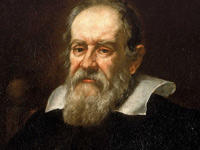
RESOURCES
This article uses material from the Wikipedia article "Galileo Galilei (1564-1642)", which is released under the Creative Commons Attribution-Share-Alike License 3.0.
© Stories Preschool. All Rights Reserved.
